The Durango mint
Located in a once rich mining area, this city is the capital of the state of Durango.
The mint was opened in 1811 by the Spanish Colonial Govemment. By independence, after more than a decade of war, the country was bankrupt and it was urgent to find mechanisms that would help resolve this situation. The mint of Durango continued its work in 1821 and 1822 during Iturbide’s reign, producing 8 reales that were the same as the previous ones with the bust of Ferdinand VII, and ⅛ and ¼ real copper coins with the legend “DE LA PROVINCIA DE NUEVA VIZCAYA”.
The state of Durango officially took over the mint on 22 May 1824 and coins were produced annually until it was closed on 30 June 1895.
Durango was one of three mints that produced 8 Reales with the Profile or Hook-neck Eagle design. However, there were problems with the quality of production in the beginning.
The early years were difficult for the State of Durango and its mint. There were times when the state did not have a legally organized government. The mint was forced to close from August 1826 until March 1827, causing the governor to complain that the loss of prestige associated with the closing would result in a reduction of the amount of metal brought in for coining. Citing the high cost of operation due to obsolete machinery, the governor recommended a study of the problems. Conditions and economics at the miny improved considerably when a 15 year lease was granted on 24 November 1829 to Manuel Bras-de-Fer and Jose Antonio Pescador.
Under their able management production grew and quality improved dramatically. In 1832 Durango became the second Mexican mint to use hub for the production of dies. When the contract with Bras-de-Fer and Pescador expired on 20 November 1844 the mint was again closed. The State of Durango requested instructions from the Federal Government with regard to the mint. Having had no word from Mexico City, early in 1845 the state legislature accepted a provisional two-year contractEl Registro Oficial, Periódico del Gobierno del Departamento de Durango, Tomo 4o, Sem. 4o. 27 February 1845 that was extendable to seven years with the approval of the Federal Government and the mint was re-opened. Although occupied by the Imperial forces of Maximilian from 4 July 1864 until March 1866, at least some production of Republican 8 Reales continued. Production of 8 Reale was halted in 1870 in favour of the Balance Scale Peso. It resumed in 1873 when that serie was discontinued. From the mid 1860 until the 1880s most of Durango's 8 Reale production was sent to the Orient.
This mint began to produce gold pieces in the year 1832 in values of ½, 1, 2 and 8 escudos. A variety of the 1836 ½ escudo is described here.
The mint also produced copper octavos (from 1824 to 1854) and cuartillas (from 1845 to 1872), with different legends according to the fact that if a Liberal government was established they carried the word "ESTADO" and if they were of the Conservative order they carried the legend "DEPARTAMENTO".
This mint was the fourth most productive in silver minting in the country after those of Mexico City, Guanajuato and Zacatecas.
It closed on 30 June 1895, when the federal government was in a position to settle the debt with the lessees and take possession.
Mint owners or lessees and their tenures
| from | to | |
| 22 May 1824 | November 1829 | Government of the State of Durango |
| 24 November 1829 | 20 November 1844 | Manuel Bras de Fer and José Antonio Pescador |
| 19 February 1845 | 29 November 1847 | Hermann Stahlknecht |
| 29 November 1847 | 30 June 1849 | H. Bernardo Georgy |
| 1 July 1849 | 24 December 1857 | Government of the Republic of Mexico |
| 24 December 1857 | 16 December 1867 | Solana, Laguerene, Gama y Cia. |
| 16 December 1867 | 31 December 1879 | Government of the Republic of Mexico |
| 31 December 1879 | 30 June 1895 | Cia. Limitada Central de Casas de Moneda de Mexico |
Assayers and their tenures (as evidence by coinage or documentation)
| Initial | Name | Began on | Left office on |
| RL | Ramón Luelmo | 1824 | 1829 |
| RM | Ramon Mascarenas | 1830 | 1849 |
| CM | Cayetano Mascareñas | 1848 | 1849 |
| 1873 | 1877 | ||
| JMR | Jose Maria Ramirez | 1849 | 1852 |
| CP | Carlos Leon de la Pena | 1852 | 1864 |
| 1867 | 1873 | ||
| LT | Luis de la Torre | 1864 | 1865 |
| JH | unknown | 1874 | 1875 |
| JMP | José María Peimbert | 1872 | |
| 1877 | |||
| PE | Pedro Espejo | 1878 | |
| TB | Trinidad Barrera | 1878 | 1880 |
| JP | José Gómez Palacio | 1880 | 1882 |
| 1890 | 1892 | ||
| MC | Manuel del Cerro | 1882 | 1890 |
| JB | Jacobo Blanco | 1885 | |
| NO | Norberto Dominguez | 1892 | 1895 |
Copper
Silver
Gold
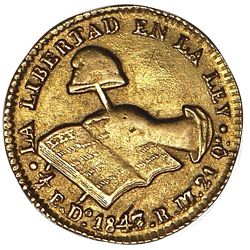
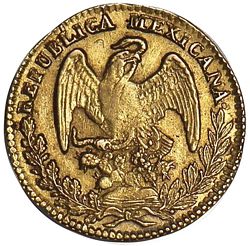
KM 378.1 ½E 1848 Do RM (Stack’s Bowers auction, 11 January 2010, lot 1348)
A variety of the 1836 ½ escudo is described here.
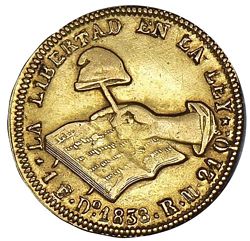
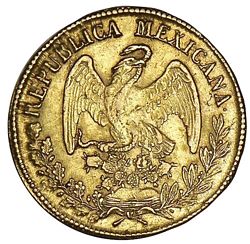
KM 379.1 1E 1838 Do RM (Stack’s Bowers auction, 11 January 2010, lot 1322)

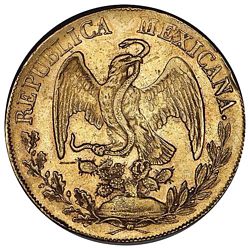
KM 383.3 8E 1854 Do CP/R (Stack’s Bowers auction, 11 January 2010, lot 1226)
